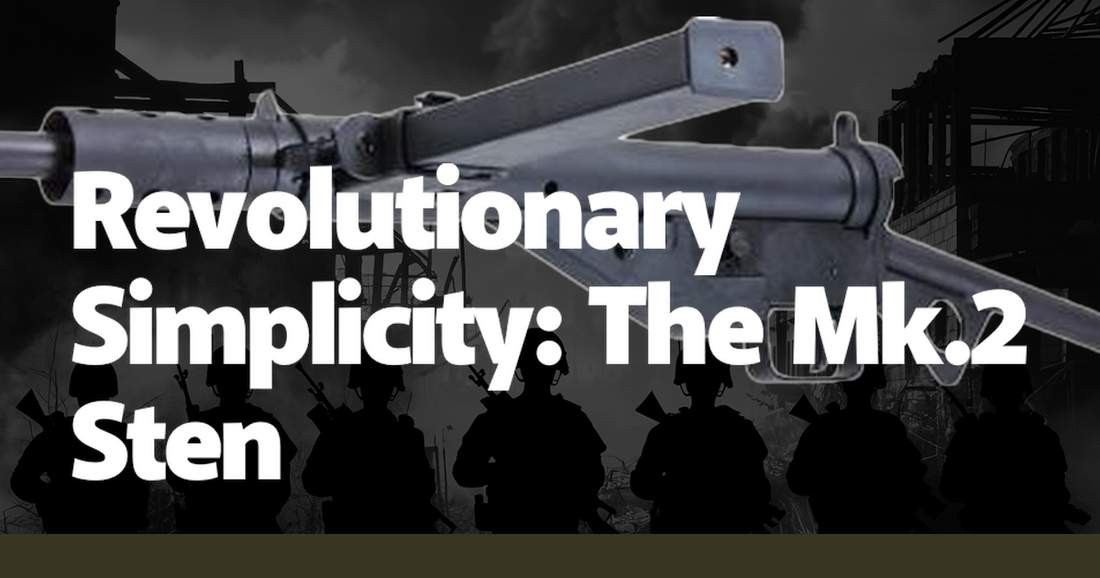The Mk.2 Sten, often referred to simply as the Sten gun, stands as a testament to wartime ingenuity and the power of simplicity in design. Developed during World War II, the Sten was a submachine gun that became synonymous with the British and Commonwealth forces. Its creation was driven by necessity; with the fall of France in 1940, the British Army found itself in dire need of a reliable, easy-to-produce weapon to arm its soldiers. The Sten's design was revolutionary in its simplicity, featuring a minimalistic approach that allowed for rapid production and ease of use, characteristics that would make it a staple in the Allied arsenal.
The Sten's design philosophy was rooted in the urgent need for mass production. Unlike the more complex firearms of the time, the Sten was constructed from stamped metal parts, which significantly reduced manufacturing time and cost. It utilized a simple blowback operation and fired from an open bolt, a design choice that not only simplified the mechanism but also enhanced cooling during sustained fire. This minimalist approach meant that the Sten could be produced in large quantities, with some estimates suggesting that over four million units were manufactured during the war. This mass production capability was crucial for the British war effort, ensuring that troops could be quickly and effectively armed.
One of the most striking features of the Mk.2 Sten was its utilitarian appearance. It lacked the polished finish and ergonomic design of other contemporary firearms, instead presenting a stark, almost crude look. The barrel was a plain steel tube, the stock a simple metal frame, and the magazine protruded awkwardly from the side. Yet, this unrefined exterior belied the weapon's effectiveness. The Sten was light, weighing just over seven pounds, and compact, making it ideal for paratroopers, commandos, and resistance fighters. Its simplicity also meant that it could be easily disassembled and reassembled, a crucial feature for maintenance in the field.
The Sten's operational history is filled with anecdotes that highlight its impact on the war. One notable example is its use during the D-Day landings, where British paratroopers and commandos relied heavily on the Sten for close-quarters combat. Its compact size and high rate of fire made it particularly effective in the tight confines of urban warfare. Another significant moment came during Operation Market Garden, where the Sten's simplicity allowed it to be airdropped in large numbers to support the airborne troops. These instances underscore the Sten's role as a force multiplier, providing the Allies with a reliable and effective weapon in critical moments.
Despite its many advantages, the Sten was not without its flaws. Its open-bolt design, while beneficial for cooling, also made it prone to accidental discharges if dropped or mishandled. The side-mounted magazine, while innovative, could cause feeding issues if not properly aligned. Additionally, the Sten's crude construction sometimes led to reliability problems, particularly in harsh conditions. However, these shortcomings were often overshadowed by the weapon's overall utility and the fact that it could be produced quickly and cheaply, a trade-off that was deemed acceptable given the circumstances of the war.
The Sten also played a significant role in the hands of resistance fighters across occupied Europe. Its ease of manufacture meant that it could be produced in clandestine workshops, providing a vital lifeline to those fighting against Nazi occupation. The French Resistance, for example, utilized the Sten extensively in their sabotage operations and guerrilla warfare tactics. The weapon's simplicity allowed it to be smuggled, hidden, and used with minimal training, making it an ideal tool for irregular warfare. This aspect of the Sten's history highlights its broader impact beyond the conventional battlefield, contributing to the overall Allied war effort in diverse and significant ways.
In the post-war period, the Sten continued to see service in various conflicts around the world. Its simplicity and low cost made it an attractive option for newly formed militaries and insurgent groups alike. The Sten's legacy can be seen in the design of subsequent submachine guns, which often borrowed elements of its straightforward, utilitarian approach. The lessons learned from the Sten's design and deployment have influenced military small arms development for decades, underscoring the enduring relevance of its revolutionary simplicity.
The Mk.2 Sten remains an iconic symbol of World War II, embodying the principle that sometimes, less is more. Its design, while born out of necessity, proved to be remarkably effective, demonstrating that a weapon does not need to be complex to be successful. The Sten's story is one of innovation under pressure, a reminder of how simplicity can triumph in the face of adversity. As we reflect on its history, the Sten serves as a powerful example of how ingenuity and practicality can combine to create something truly revolutionary.

